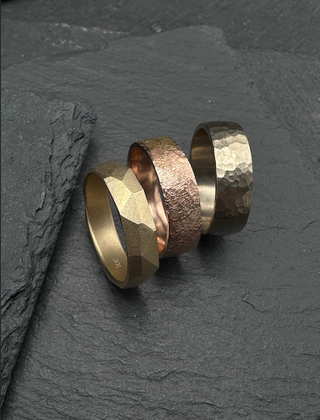
Guide to Metals
Learn more about the metals commonly used in wedding bands and the benefits and downsides to each.

Gold
Gold rings are a classic choice and definitely offer many benefits, such as these rings being easily resized and repaired. Additionally, gold can be worked to have many different designs and finishes applied to the metal so there is a great deal of flexibility in the design options of these rings.
Yellow gold is an element and precious metal that is the base for all gold alloys. In its pure state it is a vibrant yellow/orange color. Pure gold is very soft and can easily bend or scratch, so most gold has been combined with harder metals to make it more durable. Adding those metals makes the color change depending on how much and what type of metal is added. Yellow gold alloys are made by mixing pure 24k gold with silver, copper, and zinc.
Rose gold is a pinkish alloy of yellow gold. It is created by adding copper and silver to yellow gold to achieve a rosy color.
White gold is a white alloy of yellow gold. It is created by adding a white metal to yellow gold. The most common alloy of white gold in America is created by adding nickel and zinc to yellow gold. Palladium white gold has gained popularity in the US in the last 10 years or so. Palladium imbues a subtle gray to the gold and is the closest in color of the white golds to that of platinum. Palladium is also hypoallergenic and offers a great alternative to people who may be sensitive to nickel or zinc.
The purity of gold is measured in karats. Pure gold, or fine gold, is 24 Karat. Gold in its natural state is malleable and easily scratched, so adding harder metals to it increases its durability. It also makes the gold more affordable. The higher the karat, the more expensive the metal. Most jewelry is stamped/hallmarked to identify the karat of the metal (I.e. 14k, 18k).
- 24k = 100% pure gold
- 18k = 75% pure gold
- 14k = 58.5% pure gold
- 10k = 41.7% pure gold

Other Precious Metals
Platinum and Paladium are a little more expensive than gold bands but offer more durability with the same level of flexibility in design options.
Platinum is considered a noble metal and it is naturally silver/white in color. It is extremely dense but also malleable, and is often alloyed with iridium, ruthenium or cobalt depending on the jewelry application. Platinum's color does not tarnish or wear away over time, making it a great choice for commitment bands. It is also hypoallergenic.
Palladium a noble metal like platinum, is also naturally silver/white in color. Palladium is often alloyed with ruthenium for jewelry applications. Palladium is hypoallergenic, it won’t tarnish or wear away – just like platinum. Normally, it can be a cheaper alternative to platinum but palladium prices are often in flux due to industrial application demands on the metal.

Alternative Metals
Many alternative metals are more affordable than precious metals, but they have design and finish limitations and can't be resized or repaired. These rings can be cut off, but it take more time and effort to remove these rings in an emergency than a precious metal ring that is more malleable.
Stainless Steel has a bright white tone, is hypoallergenic, and is incredibly durable.
Titanium is a white metal with a more grey hue. It is very lightweight, is hypoallergenic, and very durable.
Zirconium is a natural element with a grayish-white color that is heat treated to give it a lustrous black tone. It is hypoallergenic and incredibly durable.

Patterned Metals
Mokume Gane and Damascus Steel are unique in that they are a combination of metals that creates unique patterning in the ring. Each of these rings is one of a kind because no two patterns are exactly the same. There are some sizing and repair limitations to these rings but a skilled craftsman can work with these rings to size these rings within a smaller range.
Mokume Gane, which closely translates to “wood grain metal” is an ancient Japanese technique where several layers of differently colored precious metals are fused together to create a “billet.” The billet is then forged and folded to create stunning grain-like patterns. These rings can be harder to size but a skilled craftsman can still adjust them a few sizes.
Damascus Steel is known for its graceful woodgrain-like patterns of light and dark gray. It is created by layering several steel alloys and pressure welding them together into one piece, then forging it to create dynamic patterns. Originally used to create sought after swords, this century old technique has become a popular material for contemporary jewelry. The damascus steel we carry is made with high quality stainless steel so that it does not rust.

